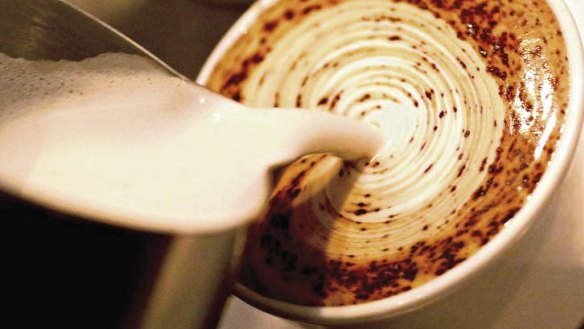Mugshot: what happened to the cappuccino?

The scene: Carlton, Melbourne, where almost every move is a performance of "Italian-ness" - the slicked-back hair and charming accent of the guy on the register who takes your order, the loud chatter of the locals ordering panini, the casual insouciance (call it studied indifference) of the waiter who drops your cappuccino on the table, spilling a little in the saucer as he spins away to resume leaning on the bar inside.
At tables on the footpath they talk with their hands, the spectacles are wire-frame Gucci and the beards are tinged with grey.
The coffee is pretty ordinary - thin foam, no milk texture, and too hot. The over-steamed milk gives the coffee's bike-tyre sweetness a bitter edge of cooked lactose. This is not Melbourne's best cappuccino, and only the chocolate on top distinguishes it from a bad flat white.
The cappuccino has fallen into disrepute, and efforts like this aren't helping. But it is still one of the drinks competitors prepare at the World Barista Championship. The WBC rules state that a cappuccino should consist of only milk and coffee - no dusting of any kind! - and that the layer of foam should be at least one centimetre deep. For flavour, judges want a balance of rich, sweet milk and espresso.
The scene shifts to a hip cafe in the inner north. The beards are tinged with irony and the spectacle frames are conspicuously large and colourful. They talk with their smartphones, not their hands.
"Yes, of course we still make cappuccino," the waiter says. The version here tastes delicious - creamy, sweet milk that's well-integrated with the coffee, just-right temperature, a nice milk-chocolate flavour and there's a pretty swirl of chocolate worked into the latte-art heart. But the foam is no more than half a centimetre deep.
Aaron Wood from Auction Rooms (coincidentally a World Barista Championship technical judge in Rimini, Italy, this year) says the main difference between cappuccino here and in Italy is that depth of foam. "Traditional cappuccinos are one-third foam, one-third milk and one-third espresso," Wood says. "Most capps in Melbourne don't have enough foam. They are more akin to a flat white with chocolate powder."
And how did the chocolate come about? Wood thinks, though he's only guessing, that it's to do with the poor quality of espresso coffee served in Australia in the past: the chocolate was sprinkled on to make the drink more palatable.
But in the past decade, coffee quality has improved out of sight, we have moved onto the flat white (or even just "espresso with milk") and the cappuccino has lost its froth.